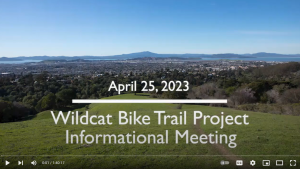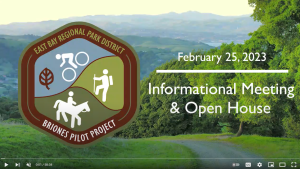OK, Mother Nature - Let's Color These Hills!
by Bob Coomber

I don't have a "favorite" season. I love Summer for the long, warm days; Fall for the leaves tumbling from the sycamores and oaks; Winter for the well, because it means Spring is next! I'm multi-seasonal that way, I guess. No favorites, as every day Mom Nature can throw something wonderful at us.
This is about a day of hiking during which you can stroll pleasantly and without a lot of effort on a short walk, or pack the lunch, snacks, water and a map in the day pack for a wonderful, if somewhat demanding loop hike. The Place: Sunol Regional Wilderness . The Trails: The Camp Ohlone Road to Little Yosemite or - A loop beginning with the McCorkle Trail and finishing with a pass through Little Yosemite.
This is one of my favorite parks, one of those places where I can never get enough. After all, the contiguous mass of parkland and trails runs from Del Valle Regional Park, through the Ohlone Wilderness, into Sunol and finally over Mission Peak. If you enjoy the outdoors with a lot of people around, Sunol is a great place. If you enjoy solitude, Sunol is a great place. The Wildflower Festival is this regional wilderness at its most colorful.

First things first, though. If you are a frequent visitor to the parks, especially those like Sunol or Del Valle where a parking fee is required, I encourage you to visit the "Volunteer/Get Involved" page and read up on becoming a member of The Regional Parks Foundation. I've been a member for years, and encourage all to take advantage of the benefits offered to Foundation members. I'd feel naked without my parking placard! Find out what I mean and take a look. I think you'll be impressed.
There are many parks within the District that are bloom-happy this time of year. From Black Diamond Mines to Tilden to the Bay Trail to Coyote Hills, you'll find wildflowers just about anywhere without looking too hard. Sunol offers such an amazing palette of natural color, though. From fiddlenecks to several varieties of lupine with tall mustard standing watch, and wild hyacinth or tidy tips waving in the breeze, you could spend the better part of the day just identifying the blooms. Don't forget the poppies, either. Or owl's clover as part of a natural patchwork quilt of color on Hayfield Road. I could go on and on and on.
But instead of reciting all sights of this time of year, I'll implore you to venture out late this month for the Festival. With the rain we've had, the falls at Little Yosemite will be going strong. The combination of a colossal bloom and waterfalls is too good to pass up. So let's get you packed, parked and on the trail.
The trailhead for both routes is at the south end of the Sunol parking lot. You should stop at the Visitor Center for a map and to chat with the expert naturalists and docents first. The Visitor Center is a quick left turn just after you proceed through the entrance kiosk. Pick up a map, and find the Camp Ohlone Road. Park near the south end of the expansive lots. Walk through the gate, where you'll be greeted by a small, gentle waterfall off to the right. This trail is wide and well graded, perfect for casual walkers or those with small kids in strollers. There are some rolling hills, but nothing too daunting. Take a moment on the old bridge which crosses Alameda Creek. Close your eyes and just listen to the water for a minute

By now, you'll have seen some of the colorful blooms which make the Wildflower Festival so special. As you wander toward Little Yosemite, just a little over a mile out, you'll be bowled over by the color and variety of flora. You may see deer munching on fresh Miner's Lettuce if you stop and look up on the hillsides. Make sure you bring a camera, too. You'll hate yourself if you forget that essential piece of gear.
Alameda Creek is far down the bluff at the trail's midpoint. As you close in on Little Yosemite the road and creek get closer to converging in elevation. The roaring falls announce in an unmistakable manner that you've arrived at Little Yosemite. It's best this time of year not to take kids too close to the water, as the flow is pretty powerful in Spring. But count Little Yosemite as another fine photo op, from dozens of angles. You'll see by this point that the color is almost exhausting in its intensity. A visitor could almost imagine a circus barker: "We got yer yellows, purples, blues and reds. We got a special little orange and gold over here, and lavender right underneath your feet."
It's a spectacular show. I haven't forgotten the more experienced hiker, either. Let's pretend you're back on the bridge, listening to the rushing water. Instead of heading straight up the trail, you make a left just as you hustle across the bridge and up a short rise. The trail marker indicates this is the McCorkle Trail. I enjoy this loop so much I roll it several times each year. Although it's not extreme, neither is it one for the unprepared. A short hill gets you up off the valley floor, and you get a quick look at what each elevation gain has to offer. With the exception of a little downhill or two, McCorkle is mostly an "up" affair. The flowers along here are gorgeous, abundant everywhere you look. Not to go into too much detail - I want YOU to hike this trail, after all - let me just say an ambitious hiker, even an ambitious novice, will have an fantastic time on the McCorkle Loop.

I mentioned making a loop circuit of this trail. There are several intersections, at Canyon View Trail or Cerro Este Trail, which will make shorter loops, but I prefer to make the entire trip, as McCorkle turns into a quiet single track route to Backpack Road, where the Ohlone Wilderness Trail meets and winds down into the park. By now I'm usually very, very tired and roll gently down Backpack Road, stopping occasionally to take in the exotic rock outcroppings, more wildflowers and a seasonal creek. The trail finally intersects with Camp Ohlone Road, more than a mile above Little Yosemite. I love the roll back, down the hill, past "The W Tree", a cool old sycamore looking like that letter of the alphabet, and onto the flat just above the waterfalls. Sometimes I sit at the edge of the road overlooking the creek, waiting for some animal to wander past. Then, as if to prove Mother Nature has mercy, the trail continues downhill. It's a grind to take a wheelchair on the McCorkle Loop. It's a relief to get to this point, as it's a simple downhill run back to the car. Finally, I finish as I began, stopping on the old bridge over Alameda Creek - listening to the water and letting my gloved hands cool.
Wildflower season in the East Bay Regional Parks is nothing short of sensational. No matter which park you choose or how long you're out there, you won't regret the visit. You might fill up a few digital memory cards, though. I hope to hear from you about your experience at 2010's Sunol Wildflower Festival. If I'm lucky, I'll see you out there!



